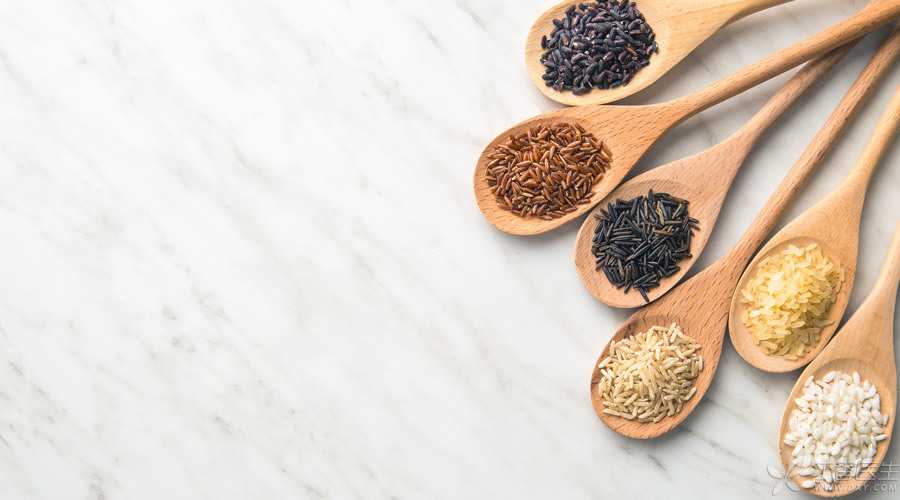
Many people go to supermarkets and may be a little tangled when they see grain and oil areas.
Indica rice, polished round-grained rice, glutinous rice, millet, purple rice, black rice… What is the difference between them and which is nutritious?
Dr. Clove will introduce you.
Indica rice, polished round-grained rice and glutinous rice
1. Indica rice
Originated from indica non-waxy rice, the rice grains are relatively [thin], the whole is slender and white (about 6 ~ 7mm), the starch content is high, the protein content is low, and the taste is not too sticky.
The common ones are Chinese fragrant rice, Thai fragrant rice, silk seedling rice, etc. According to the rice receiving season, it is also divided into early indica rice and late indica rice.
Rice particles cooked from indica rice are independent and do not adhere, which is very suitable for stewing rice.
2. Polished round-grained rice
Originated from japonica non-waxy rice, it looks more [round] on the outside, usually oval or round, and its color is transparent or translucent. Guangzhou has a very vivid name [fat rice].
Common Northeast rice, crystal rice and pearl rice are different varieties of indica rice.
Japonica rice has a more [soft and glutinous] taste than indica rice and is more suitable for cooking porridge.
3. Glutinous rice
The north is also called Jiangmi, which is white and opaque, and has a body shape… There are fat and thin glutinous rice, long and thin glutinous rice is called indica glutinous rice (long glutinous rice), and round and fat glutinous rice is called japonica glutinous rice (round glutinous rice)
Generally speaking, zongzi and tangyuan made of round glutinous rice have better taste.
Why is glutinous rice so sticky?
Because its starch composition is different. Amylopectin is the main ingredient in glutinous rice, while amylopectin is the main ingredient in indica rice and polished round-grained rice.
A large amount of amylopectin makes glutinous rice very easy to digest when it is hot and has a strong ability to raise blood sugar.

Purple rice, black rice
Purple rice is a variety of rice, mainly waxy purple rice, also known as blood glutinous rice.
Black rice is easily confused with purple rice and is a kind of non-waxy rice.
The main difference between them lies in the taste. Purple rice is generally softer and glutinous, while black rice is more chewy.
Therefore, purple rice is often used to make eight treasures rice and eight treasures porridge, while black rice is more suitable to be cooked with white rice or stewed rice.
Compared with ordinary rice, purple rice and black rice are not only rich in anthocyanins, but also rich in B vitamins, minerals, cellulose and other nutrients, and they all contain antioxidant anthocyanins (sources of purple and black), with excellent overall nutritional value.
For people who love rice, purple rice and black rice are good staple food choices.

Is millet better than rice?
Delicious millet is actually bred and domesticated from wild [dog tail grass].
Although it is small, the nutrition of millet is not ambiguous at all. Compared with rice, it contains higher protein and vitamins, its vitamin B1 content is the highest in grain, and it also contains carotene not found in common coarse grains.
Delicious millet, millet gruel, millet cold cake… worth trying!
Job’s tears are what rice again?
Job’s tears, also known as Job’s tears or Job’s tears, are not actually counted as rice.
Compared with rice, Job’s tears are rich in dietary fiber, vitamin B1 and certain vitamin E.
It has lower calories and lower fat content, and is also a good coarse cereal.

Do you want to wash rice?
Generally speaking, because impurities will inevitably enter during the shelling process, it is recommended to wash the rice before cooking. However, washing will cause some nutritional losses, so the following points should be paid attention to:
- Don’t use too hot water; Don’t rub rice hard. It can be washed 1-2 times.
Of course, if you buy rice without washing or clean rice, you can put it directly into the pot.
How to cook the most nutritious?
Rice will lose some vitamins when cooked at high temperature. The longer the cooking time, the greater the loss. Therefore, Dr. Clove suggested that everyone use pressure cookers or electric rice cookers to reduce cooking time.
There are two ways to avoid cooking:
Step 1: Fishing for rice
It refers to boiling rice in more water until it is half cooked, then taking it out and steaming it in a steamer until it is fully cooked. This cooking method will cause a large amount of water-soluble nutrients in rice to be lost in the water in the first step.
Step 2: Add alkali
In order to save time and make porridge thicker, many people add some alkaline substances, such as baking soda, when cooking porridge. However, doing so will cause serious loss of B vitamins.
